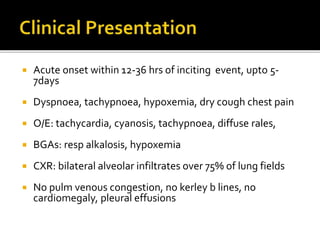Ards level 3 lecture
- 2. ? 1821 ĻC Laennec in ĄŪA treatise on diseases of the chestĄŊ ? Idiopathic anasarca of the lungs ? Trauma associated ? World war 1 & 2 ? Vietnam war
- 3. ? 1950s - Advances in critical care ? Respirators ? Airway access ? Hence the term ĄŪrespirator lungĄŊ ? Other terms related to inciting agent ? Post-traumatic, shock lung, wet lung, DaNang lung)
- 4. ? 1967 ĻC Case series of 12 patients ? acute onset ? tachypn?a ? hypox?mia ? loss of compliance Ashbaugh D, Boyd Bigelow D, Petty T, Levine B. ACUTE RESPIRATORY DISTRESS IN ADULTS. The Lancet. 1967;290(7511):319-23.
- 5. ? Hypoxemia ? Low Pa02 ? Stiff lungs ? Reduced compliance ? Hyaline membranes ? Early fibrosis in patients who died
- 6. ? Not well characterized due to lack of uniform diagnosis ? Before ICUs ĻC most patients died ? No opportunity for organized investigations ? US data ? 50,000 to 200,000 cases per year (2003) ? 79/100,000 ĻC ALI ? 59/100,000 ĻC ARDS ? 4-9% in ICU settings
- 7. ? Substantial recovery in lung function occurs within 6-12 months ? In few cases muscle weakness and neuropsychiatric problems may persist ? Mortality has improved significantly from 54% in 1983 to as low as 25% in 2004 but has plateaued since then ? Better prognosis with younger age ? Leading cause of death is multiple organ failure
- 8. ? 1967 ĻC Ashbaugh et al ? 1988 ĻC Murray and colleagues ? 1992 ĻC American European Consensus Conference (AECC) ? 2012 ĻC Berlin definition
- 9. 1. Acute onset of respiratory failure 2. Bilateral infiltrates resembling pulmonary edema 3. No evidence of left atrial pressure elevation - PCWP <18mmhg 4. Ratio of PaO2 to FiO2 is <200mmhg ĻC ? ALI ĻC 200<PaO2/FiO2 < 300mmHg (Desaturation)
- 10. ? Ą°Acute lung injuryĄą no longer exists ? Onset of ARDS (diagnosis) must be acute, as defined as within 7 days of some defined event, which may be sepsis, pneumonia, or simply a patientĄŊs recognition of worsening respiratory symptoms. TheARDS DefinitionTask Force: JAMA. 2012;307(23):2526-2533. doi:10.1001/jama.2012.5669.
- 11. ? Bilateral opacities consistent with pulmonary edema must be present but may be detected on CT or chest X-ray.
- 12. ? There is no need to exclude heart failure in the new ARDS definition ? An Ą°objective assessmentĄ°ĻC meaning an echocardiogram in most cases ĄŠ should be performed if there is no clear risk factor present like trauma or sepsis. TheARDS DefinitionTask Force: JAMA. 2012;307(23):2526-2533. doi:10.1001/jama.2012.5669.
- 14. ? Hypoventilation ? Ventilation perfusion mismatch ? Right to left shunt ? Diffusion impairment ? Reduced inspired oxygen tension (Pio2) ? Very low cardiac output
- 15. ? Common causes (mnemonic PAST) ? Pneumonia ? Aspiration ? Shock ? Sepsis ? Trauma ? *Transfusion (multiple)
- 16. ? Lung ? Contusion ? Near drowning ? Inhalational injury ? Reperfusion pulmonary edema ? Other ? Cardio-pulmonary bypass ? Drug overdose ? Acute pancreatitis (alcohol increases risk!) ? Transfusion of blood products
- 17. ? Endothelial injury ? Increased vascular permeability ĻC hallmark ? Epithelial disruption ? Alveolar flooding ? Disorganized repair leads to fibrosis ? Septic shock in patients with bacterial pneumonia ? Loss of type 2 cells ? Impaired fluid transit ĻC no fluid removal ? Loss of surfactant ? Loss of type 1 progenitor cells
- 18. ? Impaired gas exchange leading to severe hypoxemia - 2/2 ventilation-perfusion mismatch, increase in physiologic dead space ? Decreased lung compliance ĻC due to the stiffness of poorly or non-aerated lung ? Pulm HTN ĻC 25% of pts, due to hypoxic vasoconstriction,Vascular compression by positive airway compression, airway collapse and lung parenchymal destruction
- 22. Normal BGB
- 23. Small bronchiole and alveolae
- 26. ? Acute onset within 12-36 hrs of inciting event, upto 5- 7days ? Dyspnoea, tachypnoea, hypoxemia, dry cough chest pain ? O/E: tachycardia, cyanosis, tachypnoea, diffuse rales, ? BGAs: resp alkalosis, hypoxemia ? CXR: bilateral alveolar infiltrates over 75% of lung fields ? No pulm venous congestion, no kerley b lines, no cardiomegaly, pleural effusions
- 29. 1. Pneumonia 2. Diffuse alveolar hemorrhage 3. Idiopathic acute eosinophilic pneumonia 4. Cryptogenic organising pneumonia 5. Acute interstitial pneumonia 6. Rapidly progressive cancer 7. Cardiogenic pulmonary edema
- 30. ? Investigations ? Guided by clinical suspicion of underlying illness (ddx) ? For monitoring progress in patients with critical illness ? Routine e.g. ABGs ? Tests of Organ function
- 31. ? Treat underlying illness ? Minimize procedures ? Prevent complications ? Barotrauma ? DVT ? Stress ulcers ? Promptly recognize nosocomial infections ? Provide adequate nutrition
- 32. THERAPY RECOMMENDATION Low tidal volume A (strong evidence from RCTs) Minimize left atrial filling pressures B (limited clinical data) High PEEP C (recommended only as alternative) Prone positioning C Recruitment maneuvers C ECMO C High frequency ventilation D (Not recommended) Glucocorticoids D Surfactant, Inhaled NO, other anti- inflammatory D
- 33. ? Gene therapy ? Mesenchymal stem cells
- 34. ? Impaired gas exhange leading to severe hypoxemia - 2/2 ventilation-perfusion mismatch, increase in physiologic deadspace ? Decreased lung compliance ĻC due to the stiffness of poorly or nonaerated lung ? Pulm HTN ĻC 25% of pts, due to hypoxic vasoconstriction,Vascular compression by positive airway compression, airway collapse and lung parenchymal destruction


































